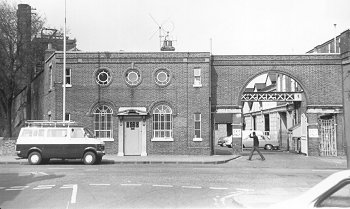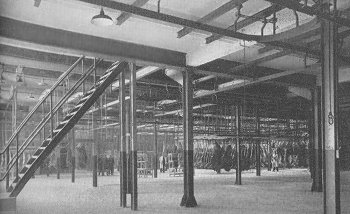|
In the 13th century Wolverhampton became a prosperous market town
catering for the surrounding area. A market has been in existence in the
town since before 1204 when the market day was moved from Sunday to
Wednesday. In 1258 King Henry III granted the town the right to hold a
weekly market every Wednesday and an annual fair. The Charter was
confirmed some years later by Edward III.
The market was a great success and large numbers of sheep and cattle
were regularly herded into Wolverhampton. By the 19th century
overcrowding was becoming a big problem due to the lack of suitable
accommodation for the livestock that choked the town centre during
market days. Cattle were herded into High Green, which was already
overcrowded with market stalls and greatly added to the general chaos.
The Wolverhampton horse market was held in Horse
Fair, which ran along present day Wulfruna Street, turned right into St.
Peter’s Square and then left behind the Civic Centre into North Street
opposite Giffard House. Horse Fair was a street full of ale houses and
against St. Peter’s Church wall stood the parish stocks. Drunkenness and
brawling were common events and on market days the parish beadle,
dressed in official livery, oversaw the drunks who would usually be
secured in the stocks for several hours.
The sheep and pig market was held in Dudley Street.
Droves of Irish pigs and Welsh sheep filled the street making it almost
impossible for anyone to get to the market. To remedy this problem the
Town Commissioners purchased a piece of land called “The Fenlands”,
which ran between Dudley Street and Queen Street, and the sheep and pigs
were moved there.
Because of the cramped conditions in High
Green, the market expanded into Lichfield Street and Darlington
Street, and both of these streets were blocked by butcher’s
stalls and a poultry market. Large quantities of bad meat was on
sale, particularly veal, and horse steaks which were sold as
prime beef, clearly something had to be done to resolve the
situation.
|
 |
In order to alleviate the problem, the Duke of
Cleveland approached the Town Commissioners with a proposal for
a cattle market on open land in Cleveland Road, next to St.
George’s Church, where the ring road is today.
He proposed that the market would be for all types of
livestock, which in an average month amounted to 3,400 sheep,
2,600 pigs, 1,000 cows and calves, and 600 horses.
The proposal, made in 1847 was accepted and a new cattle
market, designed by Edward Banks was opened in time for the July
1848 fair.
In 1856 the Fat Pig Market was opened on adjoining land. It had
stabling for 800 pigs.
|
| The market was very successful until 1865 when
there was an outbreak of cattle plague throughout the country.
As part of the preventative measures, cattle dealers had to
obtain a certificate showing that the cattle they wished to
bring to market were plague-free; and when cattle were brought
to market they had to be slaughtered before they were removed.
When these regulations came into force, trade at the cattle
market almost ceased and the market was soon in a deep financial
crisis. The Mayor, Alderman Crowther Smith called a special
meeting of the Council and expressed his anxiety for the future.
A deputation was sent to the Home Secretary and he was persuaded
to alter the legislation so that cattle brought into
Wolverhampton could be removed to a neighbouring town for
slaughter. This resolved the situation and the disease finally
disappeared in1866. |
|
The Market was held weekly for the sale of Horses
and Cattle and in its earlier years was reputed to be one of the largest
and best attended in the country. In the early 1870s as many as 220
Horses, 550 Cows, 3,000 Sheep and Lambs, 1,500 Pigs and 900 Calves were
sold weekly.
In 1929 the Municipal Abattoir, covering a little
over one and a half acres and costing just over £72,000, opened on part
of the site.
|

The Cleveland Road entrance in the 1970s.
Courtesy of David Clare. |
| At this time the Municipal Cattle Market was in
decline and it eventually closed, but its role was taken-over by
two privately owned concerns in Bilston Street, near the
abattoir.
Every Tuesday and Wednesday cattle would be unloaded from
trains at the Great Western Railway Goods Yard. The horses, cows
and pigs were driven up Stafford Street and through the town. On
Wednesday, which was market day, cattle could be coming and
going all day and sometimes they got out of control and ran wild
through the town centre. Cattle didn’t only arrive by train,
many arrived in cattle waggons which would choke the surrounding
streets.
The abattoir included a by-products plant, cold store and ice
making plant and was responsible for providing slaughtering
facilities, processing meat for human consumption, handling
inedible offals and condemned meat, and the proper storage
accommodation for carcases, particularly during warm weather.
Accommodation was also available for cattle awaiting slaughter
and by-products were manufactured using a waste elimination
plant. |
|

The carcase store at the Corporation
Abattoir. |
The animals were humanely despatched with the aid
of mechanical devices and after being dressed, electrically
operated winches and hand hoists provided a means of conveying
the carcases by an overhead track system to the different parts
of the slaughterhouse and market. Hot water used in the
slaughterhouse during the dressing process was provided by a
Lancashire boiler, which also supplied the canteen and the
by-products plant. |
|
The by-products produced were fertiliser from dried
blood, fat and grease for the soap industry, commercial grease, and
animal foodstuff made from powdered meat and bone. In the cold store,
refrigeration was carried out using an ammonia compressor. There was a
cold storage space of 80,000 cubic feet, which was mainly used for
storing meat, butter, cheese, eggs, fruit juices and dried milk.
Facilities for the storage of fruit, vegetables, milk, steel cylinders
for export, and machinery were also available. There were also special
low temperature facilities for the storage of organs for further
processing into medical supplies and an area for the private storage of
poultry, game, etc. Bacon curing was undertaken and an ice-making plant
manufactured ice for commercial use.
The cattle market and abattoir were a well known
feature on the eastern side of the town centre until the early 1970s,
when the whole area was redeveloped to make way for the ring road. The
last auction was held in November 1970. When the market and abattoir
finally closed their doors for the last time, the long tradition of
cattle trading in Wolverhampton was lost forever.
|

|
Return to
the
previous page |
|